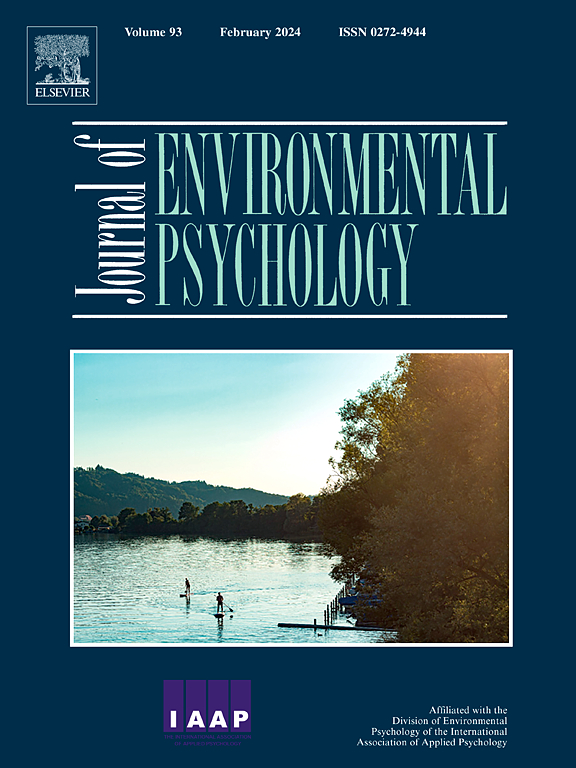从父母角度看与儿童自我调节有关的居住环境
IF 6.1
1区 心理学
Q1 ENVIRONMENTAL STUDIES
引用次数: 0
摘要
背景儿童早期缺乏自我调节(SR)技能的发展会严重影响他们未来的成功。多种理论都强调了环境对儿童发展(包括自我调节技能)的作用,而收入水平则会影响这种关系。这项研究采用了一个将环境设计理论联系起来的框架,并确定了物理环境与儿童自我调节和管理压力能力之间的关系。针对低收入家庭的物质环境因素以及这些因素如何影响儿童自我调节能力的研究十分有限。本研究采用香克的自我调节模型和生态模型来指导研究数据的收集和分析,从照顾者的角度探讨家庭环境与儿童自我调节的关系。数据是通过深入访谈收集的,参与者来自不同的收入水平和不同的种族。研究结果从照顾者的角度得出了 15 个家庭环境的可承受因素。研究的主要发现包括(1)应用于家庭物理设计中的可承受性因素越多,设计就越有利于儿童的压力管理;(2)支持性环境因素可用于解决环境产生的阻碍作用。本文章由计算机程序翻译,如有差异,请以英文原文为准。
The parental perspective of residential environments associated with children's self-regulation
Background
The lack of early development of self-regulation (SR) skills in children can significantly impact their future success. Multiple theories emphasize the role of the environment on child development including SR skills, with income level influencing this relationship. The research used a framework that ties together theories on environmental design and establishes a relationship between the physical environment and a child's ability to self-regulate and manage stress. Limited research exists on addressing physical environmental factors in low-income households and how these factors affect children's self-regulation.
Purpose
The purpose of this study is to identify physical environmental factors that can help children deal with stress. The study uses Shanker's self-regulation model and the ecological model to guide the study's data collection and analysis concerning the home environment in relation to child self-regulation from the perspective of caregivers.
Method
This research qualitatively explores affordances factors in the home physical environment in relation to child self-regulation. Data were collected through in-depth interviews and included participants from different income levels and diverse ethnicities.
Findings
Fifteen affordances factors in the home environment were derived from caregivers' perspectives. The key findings of the study include: (1) The more affordance aspects applied to the home physical design, the better the design is for the child's stress management; (2) Supportive environmental factors can be used to solve hindering effects generated by the environment.
求助全文
通过发布文献求助,成功后即可免费获取论文全文。
去求助
来源期刊

Journal of Environmental Psychology
Multiple-
CiteScore
10.60
自引率
8.70%
发文量
140
审稿时长
62 days
期刊介绍:
The Journal of Environmental Psychology is the premier journal in the field, serving individuals in a wide range of disciplines who have an interest in the scientific study of the transactions and interrelationships between people and their surroundings (including built, social, natural and virtual environments, the use and abuse of nature and natural resources, and sustainability-related behavior). The journal publishes internationally contributed empirical studies and reviews of research on these topics that advance new insights. As an important forum for the field, the journal publishes some of the most influential papers in the discipline that reflect the scientific development of environmental psychology. Contributions on theoretical, methodological, and practical aspects of all human-environment interactions are welcome, along with innovative or interdisciplinary approaches that have a psychological emphasis. Research areas include: •Psychological and behavioral aspects of people and nature •Cognitive mapping, spatial cognition and wayfinding •Ecological consequences of human actions •Theories of place, place attachment, and place identity •Environmental risks and hazards: perception, behavior, and management •Perception and evaluation of buildings and natural landscapes •Effects of physical and natural settings on human cognition and health •Theories of proenvironmental behavior, norms, attitudes, and personality •Psychology of sustainability and climate change •Psychological aspects of resource management and crises •Social use of space: crowding, privacy, territoriality, personal space •Design of, and experiences related to, the physical aspects of workplaces, schools, residences, public buildings and public space
 求助内容:
求助内容: 应助结果提醒方式:
应助结果提醒方式:


